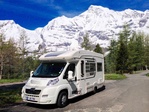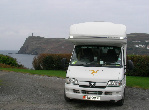Tyre Pressure Caps
+8
Cymro
Flynn
murph
boxerman
CC
modelman
Dutto
Lyonnesse
12 posters
Page 1 of 1
 Tyre Pressure Caps
Tyre Pressure Caps
I fitted my Broadway and towed Panda with dust caps that contain visual indicators of a drop in tyre pressure. Last week the Panda tyre pressure had fallen, the tyres were re-inflated and when the caps replaced the top of the cap blew off and the tyre lost all pressure. It then happened on a second tyre.
I have now removed all the caps. Is this a common problem?
Pippin
I have now removed all the caps. Is this a common problem?
Pippin

Lyonnesse- Member

- Posts : 5
Joined : 2011-12-05
Auto-Sleeper Model : Broadway
 Re: Tyre Pressure Caps
Re: Tyre Pressure Caps
Hi there,
Not familiar with the product but logic tells me that to monitor the pressure in the tyre the "gadget" has to open the valve!
If this is the case then you are relying on the thread on the "gadget" to hold back the pressure when on the move.
I have driven a variety of vehicles (cars to lorries and all in between) for nearly 50 years and relied on the "Schrader Valve" to keep the air in the tyre. During this time none has failed catastrophically.
I wouldn't touch the "gadget" you describe with a ten-foot pole!
Best regards,

Not familiar with the product but logic tells me that to monitor the pressure in the tyre the "gadget" has to open the valve!
If this is the case then you are relying on the thread on the "gadget" to hold back the pressure when on the move.
I have driven a variety of vehicles (cars to lorries and all in between) for nearly 50 years and relied on the "Schrader Valve" to keep the air in the tyre. During this time none has failed catastrophically.
I wouldn't touch the "gadget" you describe with a ten-foot pole!
Best regards,

_________________
Dutto - Living more in hope than expectation; and seldom disappointed!

Dutto- Donator

-

Posts : 7865
Joined : 2011-06-14
Location : Lincolnshire
Auto-Sleeper Model : Duetto
 Re: Tyre Pressure Caps
Re: Tyre Pressure Caps
I had somthing similar on the big-bike a couple of years back, a clear plastic top on the cap containing a green & red 'flag'.
Press them up to required pressure & they show green, any subsiquent pressure drop & it should show red, went out for a ride, felt a bit 'squishy', still showed green, but upon checking, WAAAAY down, Binned them!!
Press them up to required pressure & they show green, any subsiquent pressure drop & it should show red, went out for a ride, felt a bit 'squishy', still showed green, but upon checking, WAAAAY down, Binned them!!

_________________
I DO have to grow old, I DO NOT have to grow up!

modelman- Donator

-

Posts : 5313
Joined : 2011-09-16
Member Age : 78
Location : Barnsley,S/Yorks
Auto-Sleeper Model : Amethyst
Vehicle Year : 2003
 Re: Tyre Pressure Caps
Re: Tyre Pressure Caps
Think those gadgets you refer to that show red or green are only good for a maximum of 50 psi... I was going to invest in some until I read this in the ebay listing small print.
_________________
Get a life..... Get an Auto-Sleeper!

CC- Moderator

-

Posts : 3844
Joined : 2011-02-05
Member Age : 59
Location : North Norfolk
Auto-Sleeper Model : Broadway EB
Vehicle Year : 2019
 Re: Tyre Pressure Caps
Re: Tyre Pressure Caps
As I've said before, people sometimes get in touch with me about products they make or market that may be of interest to our members.
This is a copy of an email I received last year, I haven't any experience of the product so cannot give an opinion, apart from that it looks good:
Not wishing to contravene any etiquette on your forum I would like to post details about a tyre pressure monitoring system which we have developed for the caravan and motorhome market. Is there anywhere where I can post details as I think it could be of great interest to your members. I have a press release if you would like me to send it to you.
Regards
Peter
_________________________________________________________________
Peter Samwell
Caravan & Motorhome Specialist, TyrePal Ltd
www.tyrepal.co.uk
E-mail: peter@tyrepal.co.uk
Phone: 01404 42497
Mobile: 07798 798340
Can You Take The Pressure?
You Can Now - It's Easy With
TyrePal logo-green-1000px
Tyre Pressure Monitoring Systems
This is a copy of an email I received last year, I haven't any experience of the product so cannot give an opinion, apart from that it looks good:
Not wishing to contravene any etiquette on your forum I would like to post details about a tyre pressure monitoring system which we have developed for the caravan and motorhome market. Is there anywhere where I can post details as I think it could be of great interest to your members. I have a press release if you would like me to send it to you.
Regards
Peter
_________________________________________________________________
Peter Samwell
Caravan & Motorhome Specialist, TyrePal Ltd
www.tyrepal.co.uk
E-mail: peter@tyrepal.co.uk
Phone: 01404 42497
Mobile: 07798 798340
Can You Take The Pressure?
You Can Now - It's Easy With
TyrePal logo-green-1000px
Tyre Pressure Monitoring Systems

boxerman- Donator

-

Posts : 4491
Joined : 2011-08-21
Member Age : 77
Location : Preston Lancs
Auto-Sleeper Model : '95 Symphony
Vehicle Year : 1995
 Re: Tyre Pressure Caps
Re: Tyre Pressure Caps
Hi there,
Ninety-nine quid?
I refer readers to my previous post.
Best regards,

Ninety-nine quid?
I refer readers to my previous post.
Best regards,

_________________
Dutto - Living more in hope than expectation; and seldom disappointed!

Dutto- Donator

-

Posts : 7865
Joined : 2011-06-14
Location : Lincolnshire
Auto-Sleeper Model : Duetto
 Re: Tyre Pressure Caps
Re: Tyre Pressure Caps
Dutto wrote:Hi there,
Ninety-nine quid?
I refer readers to my previous post.
Best regards,

Aye but I've noticed that they like spendin' their brass on here


boxerman- Donator

-

Posts : 4491
Joined : 2011-08-21
Member Age : 77
Location : Preston Lancs
Auto-Sleeper Model : '95 Symphony
Vehicle Year : 1995
 tyre pressure caps
tyre pressure caps
We had some at one stage, but when ordering you had to specify what pressure you were working at, to the nearest 10 PSI if I rember correctly, and these worked well[but I forgot to remove them when we sold the van. fom what I see from the forum be cautious.
Brian
Brian
Last edited by murph on Sat Dec 17, 2011 4:28 pm; edited 1 time in total (Reason for editing : mistake on underline)

murph- Member

-

Posts : 1052
Joined : 2011-09-05
Member Age : 86
Location : Isle of Man
Auto-Sleeper Model : Lancashire EK,ES.
 Re: Tyre Pressure Caps
Re: Tyre Pressure Caps
I also had some fitted to one of my previous Vans and I would never use them again.
The big problem is that the perspexend with the indicator in is not as resillient as an ordinary dust cup. I clipped my wheel on a rock at the side of a narrow road on a mountain pass in Italy, whilst passing an oncoming vehicle. About half an hour later I had a flat tyre, caused by the the perspex cover of the valve having been damaged ( I assume) when I clipped the rock.

Flynn- Member

-

Posts : 43
Joined : 2011-07-25
Auto-Sleeper Model : Nuevo ES
 Re: Tyre Pressure Caps
Re: Tyre Pressure Caps
Flynn wrote:
I also had some fitted to one of my previous Vans and I would never use them again.
The big problem is that the perspexend with the indicator in is not as resillient as an ordinary dust cup. I clipped my wheel on a rock at the side of a narrow road on a mountain pass in Italy, whilst passing an oncoming vehicle. About half an hour later I had a flat tyre, caused by the the perspex cover of the valve having been damaged ( I assume) when I clipped the rock.
That's very interesting: recently bought a car which has a computer display which incorporates a tyre-pressure monitor. Don't know how it works - but I notice that the dust caps on the tyre valves are made of metal (as they used to be when I started driving).

Cymro- Donator

-

Posts : 3695
Joined : 2011-06-05
Location : Caerdydd - Cardiff
Auto-Sleeper Model : Nuevo ES
Vehicle Year : 2015
 Re: Tyre Pressure Caps
Re: Tyre Pressure Caps
Hi All.
My current van had these pressure indicator caps fitted when I bought it nearly 4 years ago. They work OK and I have never had a problem with them so far.
Maybe I'm just lucky. Whisky.
My current van had these pressure indicator caps fitted when I bought it nearly 4 years ago. They work OK and I have never had a problem with them so far.
Maybe I'm just lucky. Whisky.

_________________
Only two things are infinite. The Universe and Mans Stupidity.

whisky- Member

-

Posts : 2196
Joined : 2011-05-03
Location : Mansfield. Nottingham
Auto-Sleeper Model : Executive
 Re: Tyre Pressure Caps
Re: Tyre Pressure Caps
That's very interesting: recently bought a car which has a computer display which incorporates a tyre-pressure monitor. Don't know how it works - but I notice that the dust caps on the tyre valves are made of metal (as they used to be when I started driving).
The principle on a car is that it somehow detects how level the car is sitting in relation to the road. I had an alarm sound on one tyre and when I checked it had a nail in it and had deflated by 10psi. That was at the start of a 200 mile motorway trip and I would not have known other than possible handling issues.
PB
The principle on a car is that it somehow detects how level the car is sitting in relation to the road. I had an alarm sound on one tyre and when I checked it had a nail in it and had deflated by 10psi. That was at the start of a 200 mile motorway trip and I would not have known other than possible handling issues.
PB

peugeotboxer- Donator

-

Posts : 2847
Joined : 2011-06-23
Location : Somerset
Auto-Sleeper Model : Harmony
Vehicle Year : 2000
 Re: Tyre Pressure Caps
Re: Tyre Pressure Caps
peugeotboxer wrote:
The principle on a car is that it somehow detects how level the car is sitting in relation to the road.
PB
Thanks for that info. Most helpful.

Cymro- Donator

-

Posts : 3695
Joined : 2011-06-05
Location : Caerdydd - Cardiff
Auto-Sleeper Model : Nuevo ES
Vehicle Year : 2015
 Re: Tyre Pressure Caps
Re: Tyre Pressure Caps
In case anyone is interested..........
http://www.sensorland.com/HowPage040.html
For me, they're a pain because if you rotate your tyres around at a service you have to have them reprogrammed!
How did we ever manage to motor this far without them???
http://www.sensorland.com/HowPage040.html
For me, they're a pain because if you rotate your tyres around at a service you have to have them reprogrammed!
How did we ever manage to motor this far without them???

_________________
Whale oil beef hooked

dandywarhol- Donator

-

Posts : 1340
Joined : 2011-02-08
Member Age : 70
Location : Edinburgh
Auto-Sleeper Model : Ex Clubman Anniversa
Vehicle Year : 2003
 Re: Tyre Pressure Caps
Re: Tyre Pressure Caps
Apparently there are two systems.....Indirect, which uses sensors in the tyres and Indirect which somehow monitors all four tyres simultaneously as the vehicle is moving. The system I have on my car is the Indirect. If you change the wheels or adjust the tyre pressures you have to reset the system by pressing a button on the dash while the car is stationary on a level surface.
DIRECT
Direct TPMSs employ pressure sensors, either internal or external, on each tire which physically measure the tire pressure in each tire and report that information to the vehicle's instrument cluster or a corresponding monitor. These systems can identify under-inflation situations, simultaneous or singly, in any combination. Though systems vary in reporting options, many TPMS products (especially aftermarket solutions) can display real time tire pressures at each location monitored whether the vehicle is moving or parked.
Direct-sensor TPMS are specifically designed to cope with ambient and road-to-tire friction-based temperature changes, both of which heat up the tire, and increase its pressure. The alarm-activation threshold pressure for OEM systems is usually set according to the manufacturer's recommended "cold placard inflation pressures". Aftermarket system thresholds, which vary per system, can either be set at the factory or can be set by the customer during installation.
Direct sensors require power and may be either battery-powered or battery-less. In order to transfer data to the monitor or display, most direct systems utilize sensors having battery powered radio-frequency (RF) communication to transmit pressure readings and other data collected from the sensors. VisiTyre TPMS is a battery-less technology that employs maintenance free electromagnetic couplings to overcome the tire/chassis rotational boundary and eliminate "learn tool" reset and calibration procedures.
Generally, the pressure sensors used in direct-sensor TPMS can be installed inside the tire (internal sensors) or mounted on the valve stem (external sensor). Internal sensors have to be fitted to the wheel rim or to the in-tire section of the valve stem when the tire is fitted, requiring tires to be dismantled when installing or maintaining sensors. Additional interference from the metal of a tire typically requires that TPMS systems utilizing internal sensors use additional antennae to get signals to the cab on larger vehicle configurations. In comparison, external sensors are installed by being screwed onto the tire’s valve stem, replacing the dust cap, but are vulnerable to theft and physical damage.
INDIRECT
Indirect TPMS do not use physical pressure sensors but "infer" air pressures by monitoring individual wheel rotational speeds and other signals available outside of the tire itself. Most indirect TPMS systems operate under the theory of using an under-inflated tire’s slightly smaller diameter (and hence higher angular velocity) to determine inflation. Later developments of indirect TPMS can also detect simultaneous under-inflation in up to all four tires using vibration analysis of individual wheels or analysis of load shift effects during acceleration and/or cornering, which can be realized in software using advanced signal processing techniques. The vibration analysis technique may require the use of additional suspension sensors, which result in increased complexity and cost of the overall system, as long as vertical chassis movements are concerned. That is why most current advanced indirect systems use the spectral content of the wheel speed sensor signals, so no additional sensors are needed. The computations can also be carried out by existing computing power, for example in usual ABS or ESC control units.
Indirect TPMS are realized in software algorithms in combination with wheel-speed sensors for anti-lock braking systems, and electronic stability control systems. An advantage of the indirect TPMS is that it needs no sensors, thus decreasing weight and cost as well as increasing customer satisfaction, because sensor-related problems are eliminated. A disadvantage of indirect TPMS is that the driver must calibrate the system by pushing a reset button on the dashboard via an on-board computer, and if this is performed when any tire is in an under inflated condition, then the system will report erroneously. Audi was the first car maker to attempt to comply with the U.S. TPMS legislation (Tread Act), using an indirect system, with the launch of the Audi TT model year 2006. The system - called Tire Pressure Indicator TPI - purports to meet the American FMVSS 138 and the European ECE R-64 safety regulations on tire pressure monitoring systems. Unfortunately, it does not yet comply with the US DOT NHTSA regulations.
Copied from Wiki.
PB
DIRECT
Direct TPMSs employ pressure sensors, either internal or external, on each tire which physically measure the tire pressure in each tire and report that information to the vehicle's instrument cluster or a corresponding monitor. These systems can identify under-inflation situations, simultaneous or singly, in any combination. Though systems vary in reporting options, many TPMS products (especially aftermarket solutions) can display real time tire pressures at each location monitored whether the vehicle is moving or parked.
Direct-sensor TPMS are specifically designed to cope with ambient and road-to-tire friction-based temperature changes, both of which heat up the tire, and increase its pressure. The alarm-activation threshold pressure for OEM systems is usually set according to the manufacturer's recommended "cold placard inflation pressures". Aftermarket system thresholds, which vary per system, can either be set at the factory or can be set by the customer during installation.
Direct sensors require power and may be either battery-powered or battery-less. In order to transfer data to the monitor or display, most direct systems utilize sensors having battery powered radio-frequency (RF) communication to transmit pressure readings and other data collected from the sensors. VisiTyre TPMS is a battery-less technology that employs maintenance free electromagnetic couplings to overcome the tire/chassis rotational boundary and eliminate "learn tool" reset and calibration procedures.
Generally, the pressure sensors used in direct-sensor TPMS can be installed inside the tire (internal sensors) or mounted on the valve stem (external sensor). Internal sensors have to be fitted to the wheel rim or to the in-tire section of the valve stem when the tire is fitted, requiring tires to be dismantled when installing or maintaining sensors. Additional interference from the metal of a tire typically requires that TPMS systems utilizing internal sensors use additional antennae to get signals to the cab on larger vehicle configurations. In comparison, external sensors are installed by being screwed onto the tire’s valve stem, replacing the dust cap, but are vulnerable to theft and physical damage.
INDIRECT
Indirect TPMS do not use physical pressure sensors but "infer" air pressures by monitoring individual wheel rotational speeds and other signals available outside of the tire itself. Most indirect TPMS systems operate under the theory of using an under-inflated tire’s slightly smaller diameter (and hence higher angular velocity) to determine inflation. Later developments of indirect TPMS can also detect simultaneous under-inflation in up to all four tires using vibration analysis of individual wheels or analysis of load shift effects during acceleration and/or cornering, which can be realized in software using advanced signal processing techniques. The vibration analysis technique may require the use of additional suspension sensors, which result in increased complexity and cost of the overall system, as long as vertical chassis movements are concerned. That is why most current advanced indirect systems use the spectral content of the wheel speed sensor signals, so no additional sensors are needed. The computations can also be carried out by existing computing power, for example in usual ABS or ESC control units.
Indirect TPMS are realized in software algorithms in combination with wheel-speed sensors for anti-lock braking systems, and electronic stability control systems. An advantage of the indirect TPMS is that it needs no sensors, thus decreasing weight and cost as well as increasing customer satisfaction, because sensor-related problems are eliminated. A disadvantage of indirect TPMS is that the driver must calibrate the system by pushing a reset button on the dashboard via an on-board computer, and if this is performed when any tire is in an under inflated condition, then the system will report erroneously. Audi was the first car maker to attempt to comply with the U.S. TPMS legislation (Tread Act), using an indirect system, with the launch of the Audi TT model year 2006. The system - called Tire Pressure Indicator TPI - purports to meet the American FMVSS 138 and the European ECE R-64 safety regulations on tire pressure monitoring systems. Unfortunately, it does not yet comply with the US DOT NHTSA regulations.
Copied from Wiki.
PB

peugeotboxer- Donator

-

Posts : 2847
Joined : 2011-06-23
Location : Somerset
Auto-Sleeper Model : Harmony
Vehicle Year : 2000
 Re: Tyre Pressure Caps
Re: Tyre Pressure Caps
These caps also fit bicycles as do the more expensive polished metal caps. That is the problem around here. Kids pinch them.
I now use cheap plastic caps and keep a pressure gauge safe in the glove box.
I now use cheap plastic caps and keep a pressure gauge safe in the glove box.

kenjones- Donator

-

Posts : 138
Joined : 2011-04-27
Member Age : 77
Location : Shipley, West Yorkshire
Auto-Sleeper Model : T4 Topaz LE
Vehicle Year : 2004
 Re: Tyre Pressure Caps
Re: Tyre Pressure Caps
Plastic caps do the job well - metal caps have an additional seal to act as a secondary seal.
NEVER fit alloy caps - they just "weld" themselves to the valve and become impossible to remove.
driving without caps is dangerous in performance vehicles (including motorbikes). Many year ago I had a front tyre deflate on my motorcycle on a motorway - I could only put it down to the valve centrifugally overcoming the valve spring and allowing the air to escape (the cap was missing) I reinflated the tyre, fitted a cap and the incident never returned!
NEVER fit alloy caps - they just "weld" themselves to the valve and become impossible to remove.
driving without caps is dangerous in performance vehicles (including motorbikes). Many year ago I had a front tyre deflate on my motorcycle on a motorway - I could only put it down to the valve centrifugally overcoming the valve spring and allowing the air to escape (the cap was missing) I reinflated the tyre, fitted a cap and the incident never returned!
_________________
Whale oil beef hooked

dandywarhol- Donator

-

Posts : 1340
Joined : 2011-02-08
Member Age : 70
Location : Edinburgh
Auto-Sleeper Model : Ex Clubman Anniversa
Vehicle Year : 2003
 Similar topics
Similar topics» Tyre pressure
» Gas bottle sizes
» Tyre pressures Mercedes base vehicle
» Tyre pressure on a Auto sleeper Devon on Merc
» Tyre pressure
» Gas bottle sizes
» Tyre pressures Mercedes base vehicle
» Tyre pressure on a Auto sleeper Devon on Merc
» Tyre pressure
Page 1 of 1
Permissions in this forum:
You cannot reply to topics in this forum